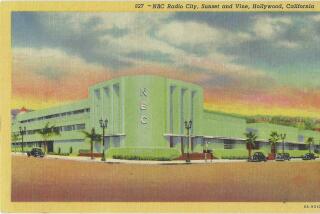Don’t touch that dial
RADIO’S Golden Age was laid to rest in the spring of 1949. Influential glossies like Life wondered if the medium had doomed itself; newspapers issued regular reports of plummeting ad sales and dismal industry morale. By April, Federal Communications Commission Chairman Wayne Coy acknowledged, to a Chicago convention of broadcasters, “Television is here and here to stay.... It is a new force unloosed in the land. I believe it is an irresistible force.”
In his book “Something in the Air: Radio, Rock, and the Revolution That Shaped a Generation,” Washington Post columnist Marc Fisher argues that what Coy and others were experiencing was a lack of vision for the auditory medium.
Since the 1920s, DJs had leaned heavily on live performances for program fodder, partly at the behest of artists and partly because station managers felt that the American people deserved better than “canned” records. After Jack Benny, Superman and the Lone Ranger fled for the more fertile ground of television, radio became paralyzed -- an antique behemoth driven by jazz and light classics.
As Fisher explains, it would take a group of visionaries to push programming into the age of rock ‘n’ roll. “Something in the Air,” which hurtles from the end of the Golden Age to the rise of Sirius and XM, is a love letter to those jocks and station managers, the true believers who created “that moment when you first heard a certain Dylan song, or the whole A side of Sgt. Pepper’s.”
It’s a nostalgic look. Since 2000, for the average American age 18 to 24, listening time has plummeted by a quarter. FM is no longer the preferred filter for rock fans to find new music. Satellite -- that great hope -- has fallen short of industry expectations. How much does radio really mean to a generation raised on podcasts, instant messaging and blogging?
Fisher never answers directly. Instead, he offers evidence of radio’s ability to reinvent itself when the need has been most dire. If we wish to make radio last long into the 21st century, he suggests, we will have to find our answers in “the real story of how media evolve,” which is “much more interesting than any on-off switch model of replacement.” Particularly, Fisher is fascinated by the story of a young Nebraskan named Todd Storz, who acquired his first station around the time of Coy’s announcement in Chicago. Storz’s formula was simple: Continually recite the call sign on air and define the station as a unique product. Insert locally focused patter from the jocks. Ditch the live tunes and, most important, play the hits.
“Storz executives quickly learned that the fewer songs they played, the higher their ratings would soar,” Fisher explains. “If they quietly cut their lists down to thirty or even twenty-five songs, the audience numbers responded immediately, always up.”
These stations weren’t playing just any songs -- they were playing rock ‘n’ roll, a genre that a majority of Americans in the early ‘50s still viewed as “race” music, “the industry term for black artists’ pop-tinged tunes with a heavy beat and lyrics packed with sexual innuendo.” This put Storz squarely in the sights of parents worried about their children’s sudden proclivity for leather jackets and industry bigwigs uncomfortable with rock’s edgy lyrics.
But the Top 40 boom was carried by more than just controversy. Fisher documents the rise of personalities such as Hunter Hancock, who catered not just to white listeners but also to blacks, and “Cousin Brucie” Morrow, who found that by talking to suburban youth (instead of talking down to them), he could exponentially enlarge his audience.
The station managers of the ‘50s and ‘60s were remarkably deft at co-opting the styles of these eclectic personalities and soon swept them into one sound that could appeal to all Americans.
The theory Fisher advances here -- and it’s a good one -- is the inverse of the modern niche-market movement Chris Anderson documented in the 2006 book “The Long Tail.” Victory in World War II had given weight to the Great American Dream and kicked off a much-needed economic boom. Storz and Top 40 were able to capitalize on this sentiment and create, Fisher writes, “[a] common soundtrack ... the deeply felt conviction that we were one community, one generation.”
It takes the ascendancy of FM radio, as the voice of the protest generation of the ‘60s, to snap Fisher out of his reverie. On WBAI, Bob Fass welcomed Bob Dylan and Abbie Hoffman into his New York City studio and encouraged them to pour their hearts out; in San Francisco, Tom Donahue’s KMPX had hippies and the Dead.
But FM, Fisher argues, was more than a simple counterculture force.
It was about the fact that a rumor of Paul McCartney’s death, started in 1969 in the Midwest, could spread across the nation, until Beatles fans everywhere were spinning “Revolution 9” backward and hearing, “Turn me on, dead man.”
It was about the growing sense that “there was no one truth, and that Life magazine and AM radio and the daily newspapers were not conveying the only version of reality that mattered.”
In other words, FM was a direct rebuke to the common soundtrack. It was also, although Fisher doesn’t explicitly make the correlation, a prelude to the niche culture of the Web and satellite radio.
Station owners were quick to capitalize on the promise of this new format, but in regeneration, the format itself, like the idealism that spawned it, didn’t last. In the late ‘70s, a young entrepreneur named Lee Abrams led FM charging down a path of automation, “pre-fab” broadcasts and a splintering of Top 40 into subgenres like adult contemporary and oldies. By the ‘80s, even the most entrenched FM guerrillas were shuttled off to fringe markets.
Radio had entered the modern period, when stations relied on computerized analysis to deliver content to meticulously researched demographic groups and DJs broadcast from towers in cities halfway across the country. The “common soundtrack” was recast as a generic FM template.
There is some dynamic reporting in the final third of “Something in the Air,” which documents the rise of public radio, the shock jocks, Clear Channel and satellite. But Fisher loses some of his fight: He has little interesting to say, for instance, about the new fields of podcasting and Internet radio.
Partly, this is a matter of Fisher’s interest in the revolution that saved radio in the ‘50s but not in the Web revolution that will have to save it now. But mostly, it’s a matter of sentimentalism. Fisher is a purist, and one must question his assertion that it’s difficult to find anyone in the business who doesn’t believe “that radio has become boring and predictable, that stations sound the same no matter where you are.”
If this is true, it’s indicative of an inability of the radio industry to fully appreciate a historical irony. After all, Wayne Coy delivered a similarly gloomy assessment for the second half of the 20th century. *
More to Read
The biggest entertainment stories
Get our big stories about Hollywood, film, television, music, arts, culture and more right in your inbox as soon as they publish.
You may occasionally receive promotional content from the Los Angeles Times.








